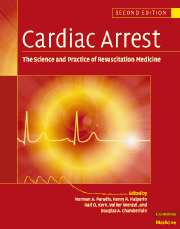Book contents
- Frontmatter
- Contents
- List of contributors
- Foreword
- Preface
- Part I Introduction
- Part II Basic science
- Part III The pathophysiology of global ischemia and reperfusion
- Part IV Therapy of sudden death
- Part V Postresuscitation disease and its care
- Part VI Special resuscitation circumstances
- 52 Prevention of sudden death in patients at risk: channelopathies and arrhythmic syndromes in the structurally normal heart
- 53 Pediatric cardiopulmonary resuscitation
- 54 Resuscitation in elder persons
- 55 Asphyxial cardiac arrest
- 56 Hemorrhagic shock and hypovolemic cardiac arrest
- 57 Cardiopulmonary resuscitation in hypothermic patients
- 58 Cardiac arrest due to poisoning
- 59 Cardiac arrest during anesthesia
- 60 Resuscitation of the pregnant patient suffering sudden cardiac death
- 61 Drowning
- 62 Anaphylactic shock
- 63 High altitude resuscitation
- 64 Electrical injuries
- 65 Rare syndromes, commotio cordis, sudden death in athletes
- Part VII Special issues in resuscitation
- Index
65 - Rare syndromes, commotio cordis, sudden death in athletes
from Part VI - Special resuscitation circumstances
Published online by Cambridge University Press: 06 January 2010
- Frontmatter
- Contents
- List of contributors
- Foreword
- Preface
- Part I Introduction
- Part II Basic science
- Part III The pathophysiology of global ischemia and reperfusion
- Part IV Therapy of sudden death
- Part V Postresuscitation disease and its care
- Part VI Special resuscitation circumstances
- 52 Prevention of sudden death in patients at risk: channelopathies and arrhythmic syndromes in the structurally normal heart
- 53 Pediatric cardiopulmonary resuscitation
- 54 Resuscitation in elder persons
- 55 Asphyxial cardiac arrest
- 56 Hemorrhagic shock and hypovolemic cardiac arrest
- 57 Cardiopulmonary resuscitation in hypothermic patients
- 58 Cardiac arrest due to poisoning
- 59 Cardiac arrest during anesthesia
- 60 Resuscitation of the pregnant patient suffering sudden cardiac death
- 61 Drowning
- 62 Anaphylactic shock
- 63 High altitude resuscitation
- 64 Electrical injuries
- 65 Rare syndromes, commotio cordis, sudden death in athletes
- Part VII Special issues in resuscitation
- Index
Summary
Introduction
Athletes deliberately expose themselves to extreme environments (such as high altitude mountaineering and deep-sea diving) and physical challenges (from weight lifting to marathon running), which may give rise to the manifestation of rare cardiac conditions, or cause sudden death (SD). Indeed, the renowned Athenian long distance runner Pheidippides suffered SD in 490 BC after running from the battlefield of Marathon to Athens to announce the great victory of the Greeks over the invaders.
An analysis of the very dissimilar physical and environmental conditions to which athletes are exposed, and related health risks, is beyond the scope of this chapter and will not be conducted. Instead, we will focus on SD from cardiac causes.
Incidence
Sudden cardiac death
It is commonly understood, and substantiated by clinical evidence, that regular moderate physical exercise has beneficial cardiovascular effects. Several prospective epidemiological studies consistently associate exercise with a reduced risk of coronary artery disease (CAD) and sudden cardiac death (SCD).
The incidence of SCD in adolescents and young adults (here defined as the age group <35 years) is about 1 in 100 000 per year; this is 100 times less than in the older population (1 in 1000 per year; Fig. 65.1). Predominant causes of SCD in athletes change with age. In those over 35 years of age, the most common etiology is atherosclerotic CAD, often severe and diffuse, even in individuals without known risk factors or symptoms. In contrast, in younger athletes, a variety of cardiac diseases, largely congenital and often rare, account for the majority of SCD.
- Type
- Chapter
- Information
- Cardiac ArrestThe Science and Practice of Resuscitation Medicine, pp. 1148 - 1198Publisher: Cambridge University PressPrint publication year: 2007
- 1
- Cited by



